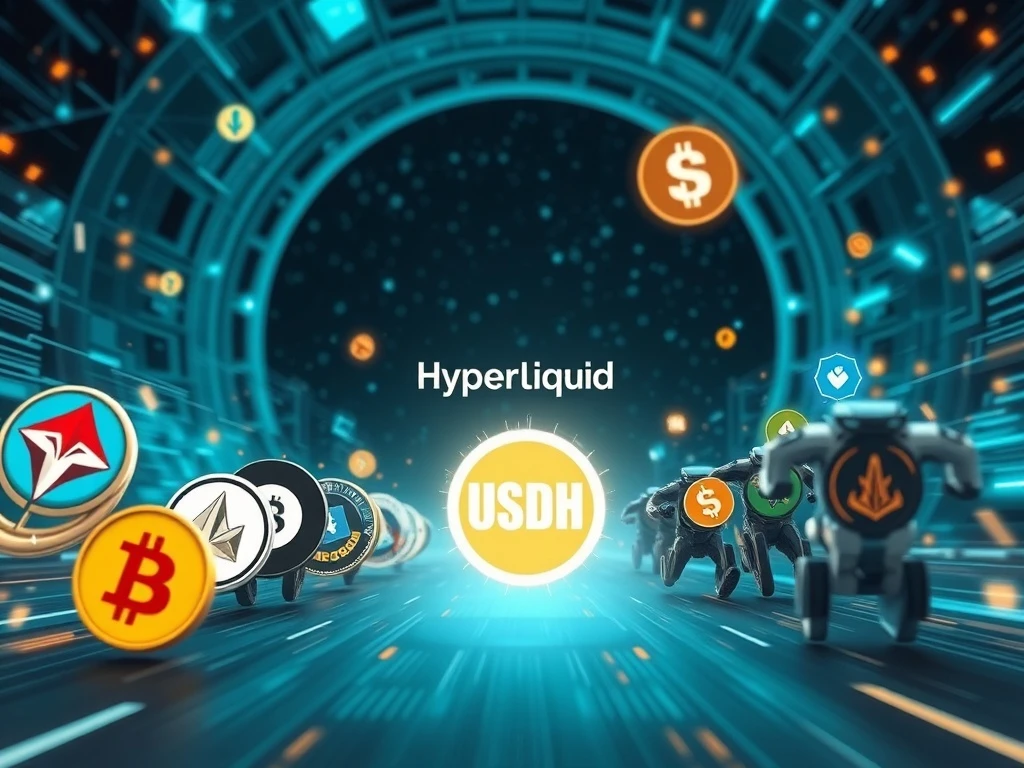Hyperliquid USDH: Intense Bidding War Ignites for Stablecoin Launch

The decentralized finance (DeFi) landscape constantly evolves. Currently, a significant development captures widespread attention. A heated stablecoin bidding war has erupted around Hyperliquid’s upcoming USDH stablecoin. Major crypto protocols are vying for the chance to power this crucial asset. This competition highlights the growing importance of native stablecoins within specific ecosystems. It also showcases the strategic value protocols place on foundational infrastructure. The outcome of this contest will undoubtedly shape the future of Hyperliquid and influence the broader crypto stablecoin market.
Sky (MakerDAO) Joins the Hyperliquid USDH Race
Sky, formerly known as MakerDAO, has officially entered the race to launch Hyperliquid’s USDH stablecoin. This move marks Sky as the fifth major crypto protocol to propose its expertise. Rune Christensen, Sky’s co-founder, unveiled their comprehensive proposal on Monday. He detailed Sky’s extensive resources. He also promised a highly customizable token. Notably, this token could offer a yield rivaling traditional US Treasury bills. Sky’s entry significantly escalates the competition. Many observers consider them a formidable contender.
Christensen emphasized the unique advantages Sky brings. “By using Sky to power USDH, the Hyperliquid community will gain unbeatable advantages that no other stablecoin project can offer,” he stated. Sky’s track record is impressive. It created and backs both USDS and Dai (DAI). These are the fourth and fifth-largest stablecoins, respectively. Together, they command a market capitalization of approximately $12.5 billion. This experience positions Sky as a seasoned player in the DeFi stablecoin arena. Hyperliquid initially posted its request for proposals on Discord last Friday. Since then, interest has been immense.
Sky’s Compelling Offer: Yield, Compliance, and Growth for Hyperliquid USDH
Sky’s proposal for Hyperliquid USDH is robust and multi-faceted. It outlines several key benefits for the Hyperliquid community:
- Attractive Yield: Hyperliquid would receive a 4.85% return on all USDH held on its platform. Christensen highlighted this rate as “significantly above the T-Bill rate.” This attractive yield mechanism could incentivize adoption.
- USDS Conversion: USDH will offer seamless conversion to and from a version of Sky’s USDS stablecoin. This USDS variant provides its holders with a 4.75% yield.
- Native Multichain: The stablecoin will be “natively multichain.” It will utilize the cross-blockchain protocol LayerZero for broad interoperability.
- Customization & Compliance: Hyperliquid can customize USDH under Sky’s guidance. For instance, it could comply with US stablecoin laws like the GENIUS Act. This act typically bans stablecoin issuers from paying yield. Sky offers pathways for regulatory adherence.
- Ecosystem Growth Fund: Sky commits $25 million to establish a project. This initiative aims to “autonomously grow DeFi on Hyperliquid.” It will feature exclusive tokens. These tokens could potentially generate billions for the protocol.
These features underscore Sky’s commitment. They aim to deliver a high-performance and adaptable stablecoin solution. The focus on yield and regulatory compliance addresses critical market demands. Furthermore, the growth fund demonstrates a long-term vision for the Hyperliquid ecosystem.
The Broader Stablecoin Bidding War for Hyperliquid’s Future
Sky’s bid is one of several compelling proposals. Hyperliquid’s call for a “Hyperliquid-first, native stablecoin with the ticker USDH” sparked considerable interest. This request generated a vibrant stablecoin bidding war. Several other prominent entities have also submitted their pitches. These include both established players and innovative newcomers.
The first proposal came from Native Markets. This new venture was set up by Hyperliquid advocate Max Fiege. Native Markets suggests using Stripe’s stablecoin payment processor, Bridge, to issue USDH. This approach leverages existing payment infrastructure. It could offer a streamlined path to market. Other significant contenders have also emerged. These include the well-known stablecoin protocol Frax. Frax is recognized for its hybrid stablecoin model. Stablecoin issuer Paxos, a regulated entity, also submitted a bid. Paxos has extensive experience with regulated stablecoins like USDP and BUSD. Finally, crypto infrastructure firm Agora entered the fray. Agora benefits from backing by the crypto fintech MoonPay. Each bidder brings unique strengths and value propositions to the table. This diverse competition reflects the strategic importance of Hyperliquid’s stablecoin initiative within the broader DeFi ecosystem.
VanEck CEO Appeals to the Hyperliquid Community in the Crypto Stablecoin Market
The stablecoin bidding war also attracted attention from traditional finance. Jan van Eck, CEO of investment giant VanEck, publicly appealed to the Hyperliquid community. His son, Nick van Eck, co-founded Agora. Jan van Eck’s post on X (formerly Twitter) on Monday seemingly backed his son’s stablecoin bid. He expressed enthusiasm for collaboration. “We’d be thrilled to be a part of your community’s ecosystem,” he wrote. He also highlighted their engagement with HyperEVM builders. “We continue to look for new ways to contribute to Hyperliquid,” he added. This contribution could be “through this Agora proposal or something else in the future.”
Van Eck also conveyed a strong message of independence. “But we don’t like being gang-tackled,” he stated. He continued, “You wouldn’t want us as a partner if we were pushed around easily.” This comment underscores the competitive nature of the bids. It also suggests a desire for fair consideration. The appeal from such a high-profile figure further legitimizes the importance of this decision. It demonstrates the intersection of traditional finance and the rapidly evolving crypto stablecoin market. The Hyperliquid validators will ultimately vote on their preferred proposal. This decision will follow the network’s next upgrade, which remains unannounced.
The Strategic Importance of a Native DeFi Stablecoin
A native stablecoin like Hyperliquid USDH holds immense strategic value. For a decentralized perps exchange like Hyperliquid, it can:
- Enhance Liquidity: A native stablecoin often attracts deeper liquidity. This improves trading efficiency and reduces slippage.
- Reduce Dependencies: It lessens reliance on external stablecoins. This can mitigate risks associated with other protocols.
- Foster Ecosystem Growth: It acts as a foundational asset. Developers can build new applications and services on top of it. This directly supports the DeFi ecosystem growth.
- Improve User Experience: Users can transact and collateralize with a stablecoin deeply integrated into the platform. This often leads to a more seamless experience.
- Capture Value: The protocol can capture more value from its own stablecoin. This benefits the community and token holders.
The competition among these major protocols highlights this strategic importance. Each bidder understands the potential impact. A successful USDH launch could significantly elevate Hyperliquid’s position. It could also set a new standard for native stablecoin integration. This development is keenly watched across the entire crypto stablecoin market.
Future Outlook for the Hyperliquid USDH Stablecoin
The decision regarding Hyperliquid USDH will have lasting implications. The chosen partner will play a crucial role in its design, issuance, and management. This partnership could redefine Hyperliquid’s offerings. It might also influence how other DeFi protocols approach stablecoin integration. The market eagerly awaits Hyperliquid’s announcement. The community’s vote will ultimately determine the future direction. This decision represents a pivotal moment for the decentralized exchange. It also signals a maturing trend in the DeFi ecosystem, where custom-tailored stablecoins are becoming increasingly vital. The intense competition ensures that Hyperliquid will likely select a partner capable of delivering a robust, secure, and highly functional stablecoin. This will benefit users and strengthen the protocol’s overall standing.










